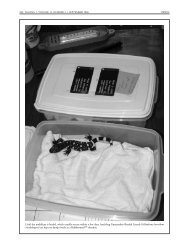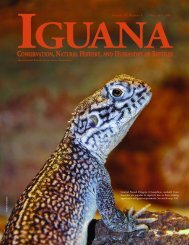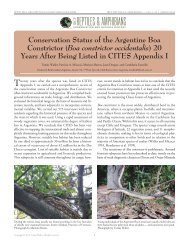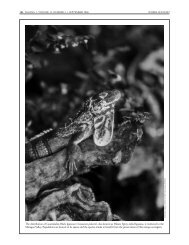Spiny-tailed Iguanas (Ctenosaura similis) in Venezuela
Spiny-tailed Iguanas (Ctenosaura similis) in Venezuela
Spiny-tailed Iguanas (Ctenosaura similis) in Venezuela
You also want an ePaper? Increase the reach of your titles
YUMPU automatically turns print PDFs into web optimized ePapers that Google loves.
FOCUS ON CONSERVATION<br />
Conserv<strong>in</strong>g Southern California’s<br />
Mounta<strong>in</strong> Yellow-legged Frog (Rana muscosa)<br />
Accord<strong>in</strong>g to the World Conservation Union, at least one-third of the world’s estimated 6,000 amphibian species are<br />
threatened with ext<strong>in</strong>ction. Many of these amphibians reside <strong>in</strong> the United States, and two critically endangered species,<br />
the Mounta<strong>in</strong> Yellow-legged Frog (Rana muscosa) and the California Red-legged Frog (Rana draytonii), reside <strong>in</strong> California.<br />
In close partnership with the U.S. Fish and Wildlife Service, the U.S. Forest Service, the U.S. Geological Survey, and<br />
California Department of Fish and Game, the San Diego Zoo’s Conservation and Research for Endangered Species (CRES)<br />
is participat<strong>in</strong>g <strong>in</strong> the recovery of the critically endangered Mounta<strong>in</strong> Yellow-legged Frog (Rana muscosa). In August 2006,<br />
CRES received 82 Mounta<strong>in</strong> Yellow-legged Frog tadpoles. These animals were salvaged from a dry<strong>in</strong>g streambed <strong>in</strong><br />
Southern California’s San Jac<strong>in</strong>to Mounta<strong>in</strong>s. The tadpoles were brought to the Applied Animal Ecology lab at CRES,<br />
where they were housed <strong>in</strong> spacious aquaria. As of August 2008, the rema<strong>in</strong><strong>in</strong>g 62 frogs are all near<strong>in</strong>g adult size and are<br />
show<strong>in</strong>g breed<strong>in</strong>g behaviors. Some frogs will be moved to other AZA <strong>in</strong>stitutions for breed<strong>in</strong>g, and all progeny will be<br />
released with<strong>in</strong> the historical range of the species <strong>in</strong> a project designed to monitor the fate of released frogs and develop an<br />
optimal release strategy. The project will end when the conservation partners determ<strong>in</strong>e that captive propagation is no<br />
longer useful for recovery efforts, an outcome expected to be more than 10 years <strong>in</strong> the future.<br />
California populations of the Mounta<strong>in</strong> Yellow-legged Frog were listed as endangered by the U.S. Fish and Wildlife Service<br />
<strong>in</strong> 2002. Despite this protection, these frogs cont<strong>in</strong>ue toward ext<strong>in</strong>ction, with only seven known populations rema<strong>in</strong><strong>in</strong>g <strong>in</strong><br />
southern California, each rang<strong>in</strong>g <strong>in</strong> size from seven to no more than 75 adults. While habitat loss historically has been the<br />
lead<strong>in</strong>g cause of amphibian decl<strong>in</strong>e, the most immediate threat is from the chytrid fungus. In addition to recent fire and<br />
drought damage, the decl<strong>in</strong>e of the frog is further compounded by non-native predators such as bullfrogs and trout, and<br />
possibly by airborne and aquatic contam<strong>in</strong>ants.<br />
Jeff Lemm<br />
Research Coord<strong>in</strong>ator<br />
Applied Animal Ecology Division<br />
CRES, Zoological Society of San Diego








